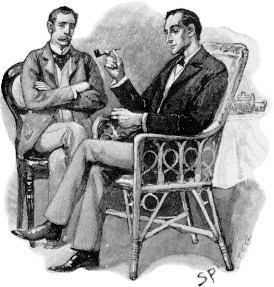 | ||
The Dynamics of An Asteroid is a fictional book by Professor James Moriarty, the implacable foe of Sherlock Holmes. The book is described by author Arthur Conan Doyle in "The Valley of Fear" (written in 1914, but set in 1888) when Sherlock Holmes, speaking of Professor Moriarty, states:
Contents
- Related real works
- Discussion of possible book contents
- Related references in media
- Citation analysis
- References
Is he not the celebrated author of The Dynamics of an Asteroid, a book which ascends to such rarefied heights of pure mathematics that it is said that there was no man in the scientific press capable of criticizing it?
With this class of talent, Professor Moriarty evoked the profound respect of Sherlock Holmes, one of the few opponents to do so (Irene Adler being another).
Doyle also portrayed Professor Moriarty as the author of "a treatise on the binomial theorem", written when he was only 21 years of age. In addition to covering a completely different topic, it must have been quite a bit more accessible, since it got him a position as a chair of mathematics at a provincial university.
Related real works
In 1809, Carl Friedrich Gauss wrote a ground-breaking treatise on the dynamics of an asteroid (1 Ceres). However, it was understood immediately and his method is still used today (see Gauss' Method).
Two decades before Arthur Conan Doyle's writing, the Canadian-American dynamic astronomer Simon Newcomb had published a series of books analyzing motions of planets in the solar system. The notoriously spiteful Newcomb could have been an inspiration for Professor Moriarty.
An example of mathematics too abstruse to be criticized is the letters of Srinivasa Ramanujan, sent to several mathematicians at the University of Cambridge in 1913. Only one of these mathematicians, G. H. Hardy, even recognized their merit. Despite being experts in the branches of mathematics used, he and J.E. Littlewood added that many of them "defeated me completely; I had never seen anything in the least like them before." It should be noted that Holmes says only that "it is said" (emphasis added) that no one in the scientific press was capable of criticizing Moriarty's work; he stops short of recognizing the claim as indisputably accurate.
Discussion of possible book contents
Doyle provided no evidence relating to the contents of Dynamics. This has in no way prevented people from speculating about what it contained.
Other speculation on this topic includes:
Related references in media
Citation analysis
Citation analysis, which involves examining an item's referring documents, is used in searching for materials and analyzing their merit. Since citation analysis does not look at a document's contents, only references to it, it can be applied to a documents such as Dynamics or Treatise that do not in fact exist.
Dynamics is referenced in the professional scientific literature and in textbooks.
The list in the previous section shows 42 references to Dynamics and 27 to Treatise, which are a lower limit, since the list is not up to date. An online search, as of 2005, for these titles with author Moriarty, reveals 263 references to Dynamics and 209 to Treatise. These are very high numbers for any scientific paper, where the overall average is about 6 references. They are even more numerous when compared to other papers from the same era – by 1900, the Royal Society's Catalog of Scientific Papers already listed 800,000 papers from 3,000 journals. Most of these have been forgotten, and only a few are still referenced today, as shown by analyses of references to old scientific articles.
The Dynamics of An Asteroid is among the select group of Victorian scientific works that are still remembered and referenced even today, despite (or perhaps because of) its fictional existence.
